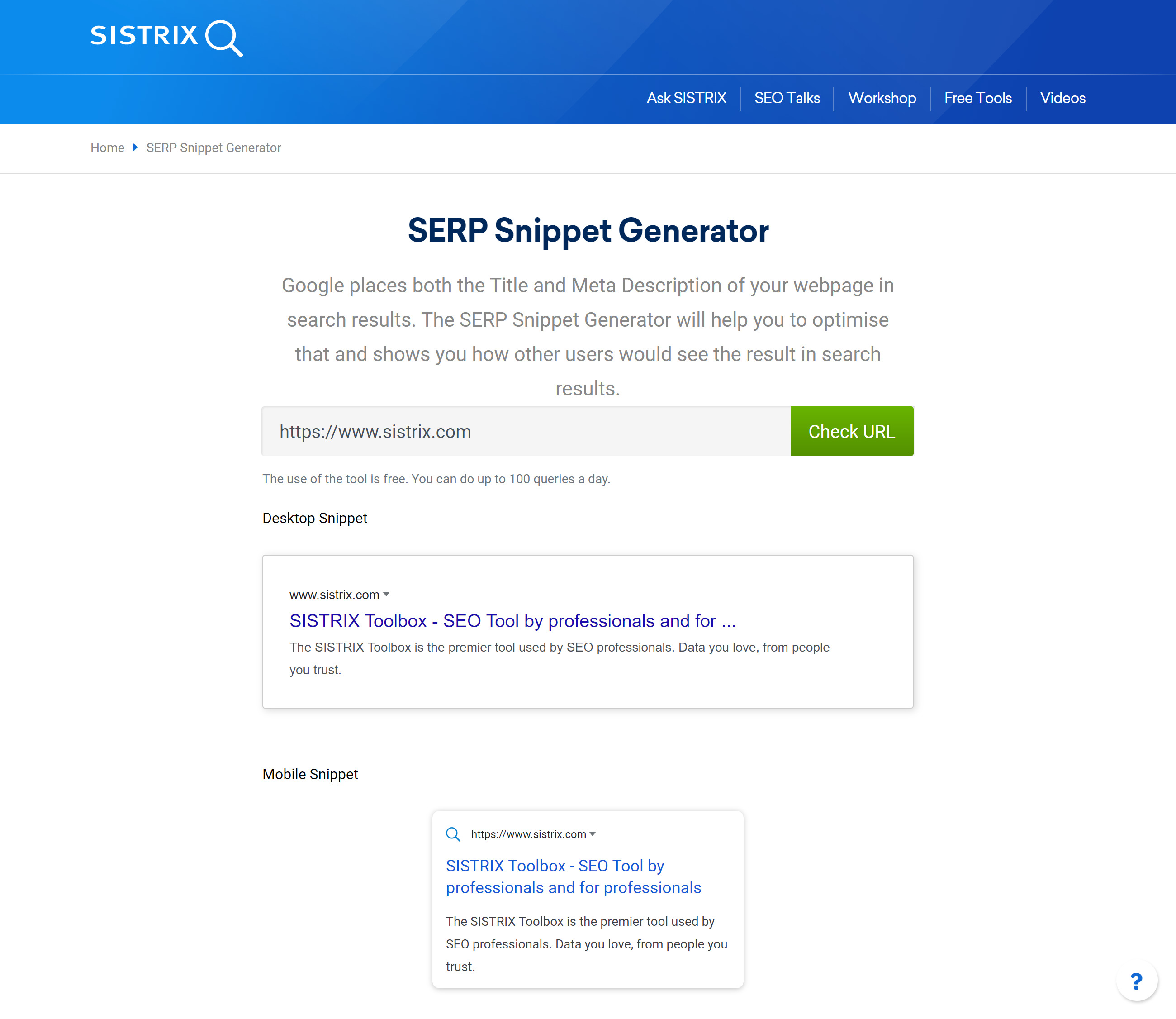Special characters and emojis help to increase the click rate of your own search positions: whatever attracts attention, also attracts clicks. But Google is showing fewer and fewer special characters in SERPs. We analyzed what still works today.
Discover how SISTRIX can be used to improve your search marketing. 14 day free, no-commitment trial with all data and tools: Test SISTRIX for free
A few weeks ago we shared an analysis showing that click rates in search results are often lower than previously assumed. The organic click rates suffer especially when Google integrates its own features.
The use of emojis and special characters is still a popular trick used to attract more attention. However, Google has recognized this trend and is showing less and less of these attention-grabbing and click-generating elements in search results.
To learn what is still working in the Google SERPs today, we evaluated the title and snippet of 3,365,835,367 search results . Here are the key findings in the summary:
- Displaying special characters and emojis in the title is much more difficult than displaying them in the snippet (text).
- Google often allows different special characters in the snippet than in the title. You have to optimize both elements separately and use different special characters & emojis.
- Use our table of the most frequently viewed special characters and emojis to maximize the chance that Google will display them.
- Most successful emoji in the title : 🥇is by far the most successful emoji in the title with 0.06%. On the places for emojis in the title: 🤑 (0.01%) and 🥾 (0.008%).
- The most successful special character in the title are arrows : » in 0.89% of all titles. Also widespread: ▷ (0.51%), ᐅ (slightly different arrow, 0.34%) and ⇒ (0.14%).
- Most successful emoji in the snippet : ✅ (0.52%), followed by ❌ (0.08%) and ⭐ (0.06%).
- The special character in the snippet : ✓ is found in 2.94% of all snippets and thus the most widespread special character in the Google SERPs. Also successful: » and « as well as ➤ and ☎.
Let’s continue with the full evaluation and background on this topic:
Why should I use emojis and special characters?
Your goal with SEO is to guide interested visitors from the Google search results to your website . Your success depends on how often your keywords are searched and how many of the searchers click on your search positions.
This click rate in turn depends on the ranking of the search position and how the SERPs are structured – i.e. whether Google is using other attention-grabbing integrations there. To increase your click rate you have two levers: you can try to achieve a better ranking or you can draw more attention from visitors to your search position.
For the second approach, emojis and special characters in the search results are suitable. They help you to stand out from the crowd of results and thus get more clicks than you are actually entitled to for your ranking. This can be clearly seen in this search result.

The search result has a strongly optimised snippet for the keyword “gravel bike”. An emoji heart is integrated into the title and in the snippet itself you’ll find even more special characters next to the finger pointing at the title. This result stands out in the SERPs and is clicked more often than a non-optimized snippet.
Does Google show all the special characters?
Google recognised this SEO trend a long time ago . For highly competitive keywords, the complete organic top 10 consisted of results that vied for attention with emojis and special characters.
In response , Google no longer shows all special characters and emojis – even if they are included in the title tag or the meta description of the page.
Unfortunately, there are no fixed and public rules or guidelines according to which Google displays these elements. In general, however:
- There are significantly less special characters in the title and significantly less Emojis displayed in the snippet of the result.
- The more attention-grabbing an item is, the less likely it is that Google will display it.
- The opportunity to include monochrome special characters in the title or the snippet leads to a much better chance for Google to accept them.
- The display of emojis is highly dependent on the context and the search intention. If someone searches for emojis, they will also be displayed. But not for other keywords (for the same search result).
In the more than 3 billion search results evaluated, we were able to find 11,767 different non-Ascii characters in the titles. In the snippets there were 30,631 different characters. This includes not only emojis and special characters to increase attention, but also exotic characters.
For example, the character “༇” (the Tibetan character for yig mgo tsheg shad ma, a kind of page break) can only be found in one of the 3,365,835,367 hits in the title.
How do I get special characters and emojis in my results now?
The purely technical part is simple: you add the special characters or emojis to the Title Tag or Meta Description of your website. The next time the Googlebot records this URL, the title and snippet are updated in the Google index and are available to Google for display in the search results.
If you would like to try something out with possible special characters and emojis in order to make the best possible use of the available space and to see beforehand how different elements will work in combination, you can use our free SERP snippet generator.

The big question now is: will Google also display your emojis and special characters in the SERPs? Unfortunately there is no definitive answer for this, you have to try it out. To increase the chances of discovering the right elements faster, we analysed what works in the SERPs:
Which emojis and special characters still work?
We evaluated 3,365,835,367 search results to find out which emojis and special characters are displayed most frequently. As we have seen, Google does not display all the elements that are in the title or meta description, but rather weighs up the relevance of the search query and the website.In the following table you will find a list of the most frequently displayed special characters and emojis in the title and snippet. The lists are sorted in descending order of frequency – what is higher in the list works well on Google:
| Special characters / Emojis in Title | Distribution in SERPs | Special charachters / Emojis in Snippet | Distribution in SERPs |
|---|---|---|---|
| » | 0.894% | ✓ | 2.948% |
| ▷ | 0.513% | » | 0.825% |
| ᐅ | 0.346% | « | 0.559% |
| « | 0.229% | ✅ | 0.515% |
| › | 0.211% | ➤ | 0.479% |
| ⇒ | 0.149% | ☎ | 0.318% |
| 🥇 | 0.064% | ✉ | 0.142% |
| 【 | 0.045% | ☆ | 0.141% |
| 】 | 0.040% | ▻ | 0.108% |
| ⇔ | 0.040% | ▷ | 0.104% |
| → | 0.034% | › | 0.098% |
| ⋆ | 0.030% | → | 0.094% |
| ✔ | 0.017% | × | 0.094% |
| 🤑 | 0.012% | ⌚ | 0.092% |
| √ | 0.012% | ᐅ | 0.091% |
| ❤ | 0.012% | ❌ | 0.083% |
| ❶ | 0.011% | ☀ | 0.082% |
| ‹ | 0.008% | ❤ | 0.077% |
| ≫ | 0.008% | ⭐ | 0.066% |
| 🥾 | 0.008% | ⇒ | 0.060% |
| ᐈ | 0.006% | ♥ | 0.057% |
| ≡ | 0.006% | ✚ | 0.054% |
| ¤ | 0.005% | † | 0.044% |
| ≥ | 0.005% | ✈ | 0.043% |
| † | 0.005% | ○ | 0.039% |
| ※ | 0.005% | ✔ | 0.032% |
| ⭐ | 0.004% | 【 | 0.028% |
| ☀ | 0.004% | ⇔ | 0.028% |
| ✊ | 0.004% | ✭ | 0.027% |
| ✈ | 0.003% | 】 | 0.026% |
| ± | 0.002% | ➔ | 0.026% |
| ➡ | 0.002% | ⏲ | 0.024% |
| 🦊 | 0.002% | ➜ | 0.022% |
| ❷ | 0.002% | ➽ | 0.021% |
| ∗ | 0.002% | ↑ | 0.020% |
| ◁ | 0.001% | ➨ | 0.020% |
| 《 | 0.001% | ¶ | 0.019% |
| ‣ | 0.001% | ± | 0.017% |
| ↔ | 0.001% | √ | 0.016% |
| 🦄 | 0.001% | 🧡 | 0.015% |
| 》 | 0.001% | ¤ | 0.014% |
| 🤔 | 0.001% | ☑ | 0.014% |
| ~ | 0.001% | ❗ | 0.012% |
| ← | 0.001% | ➥ | 0.012% |
| ① | 0.001% | ⌂ | 0.011% |
| ♥ | 0.001% | ✌ | 0.011% |
| 🦁 | 0.001% | ✆ | 0.010% |
| ᐉ | 0.001% | ← | 0.009% |
| ❹ | 0.001% | ♢ | 0.008% |
| ∞ | 0.001% | ▽ | 0.008% |
| 🅾 | 0.001% | ⚽ | 0.008% |
| 🤘 | 0.001% | ✨ | 0.007% |
| ⚡ | 0.001% | ➡ | 0.007% |
| ‼ | 0.001% | ⚡ | 0.007% |
| ✓ | 0.001% | ↓ | 0.006% |
| ☎ | 0.001% | ✦ | 0.006% |
| ♀ | 0.001% | Ω | 0.006% |
| ▶ | 0.001% | ♫ | 0.006% |
| ② | 0.001% | ↔ | 0.005% |
| ❸ | 0.001% | ✪ | 0.005% |
| ≈ | 0.001% | 〉 | 0.005% |
| ⚽ | 0.001% | 〈 | 0.005% |
| ᐊ | 0.001% | ▸ | 0.005% |
| ⚖ | 0.000% | ♡ | 0.005% |
| ➤ | 0.000% | ✿ | 0.005% |
| ʘ | 0.000% | ⇨ | 0.005% |
| 🥃 | 0.000% | ♀ | 0.005% |
| ♂ | 0.000% | く | 0.005% |
| 🦋 | 0.000% | ✩ | 0.005% |
| ❗ | 0.000% | ◷ | 0.005% |
| ↑ | 0.000% | ❯ | 0.004% |
| ᐃ | 0.000% | ♂ | 0.004% |
| ☆ | 0.000% | ☼ | 0.004% |
| ⚠ | 0.000% | ▶ | 0.004% |
| ⋙ | 0.000% | ◇ | 0.004% |
| 🌤 | 0.000% | ☝ | 0.004% |
| ❄ | 0.000% | ◅ | 0.004% |
| 😍 | 0.000% | ✂ | 0.004% |
| ♻ | 0.000% | △ | 0.004% |
| 🤣 | 0.000% | 🥇 | 0.004% |
| 🤗 | 0.000% | ⛱ | 0.003% |
| ⓵ | 0.000% | ❖ | 0.003% |
| 🦅 | 0.000% | ❱ | 0.003% |
| ‡ | 0.000% | 》 | 0.003% |
| ✉ | 0.000% | 《 | 0.003% |
| 🤓 | 0.000% | ✘ | 0.003% |
| 🏆 | 0.000% | ✮ | 0.003% |
| 〉 | 0.000% | ↗ | 0.003% |
| ⁂ | 0.000% | ⬌ | 0.003% |
| 🎮 | 0.000% | ☺ | 0.003% |
| ⛱ | 0.000% | ⏰ | 0.003% |
| ᗌ | 0.000% | ∆ | 0.003% |
| 🥐 | 0.000% | ➦ | 0.003% |
| ๏ | 0.000% | ‡ | 0.002% |
| ☺ | 0.000% | ♪ | 0.002% |
| ⛳ | 0.000% | ✰ | 0.002% |
| ☑ | 0.000% | № | 0.002% |
| 🦉 | 0.000% | ❄ | 0.002% |
| ∆ | 0.000% | ❀ | 0.002% |
| 🥂 | 0.000% | ⚠ | 0.002% |
It is noticeable that the overlap between the two lists is very small : what works in the title will not work in the description and vice versa. You have to select different special characters and emojis for both SERP elements.
It can also be seen directly that special characters and emojis are used significantly more often in the snippet than in the title. So Google applies higher standards to the title than to the snippet. It is therefore a good idea to experiment with the snippet first and then with the title.
Conclusion
The use of special characters and emojis is still a recommended way to increase the click rate of your results. However, Google has increased the requirements so that these elements are actually displayed in the SERPs.
You have to optimize the title and snippet separately from each other – Google gives preference to different special characters and emojis in both areas.
Use the data from our table to maximize the likelihood that Google will also display these special characters and emojis. First optimize your snippet using the meta description and afterwards the title.
With the free snippet generator you can try out beforehand how special characters and emojis are displayed in the SERPs. As with all SEO topics, the same applies here: don’t overdo it.
Test SISTRIX for Free
- Free 14-day test account
- Non-binding. No termination necessary
- Personalised on-boarding with experts
